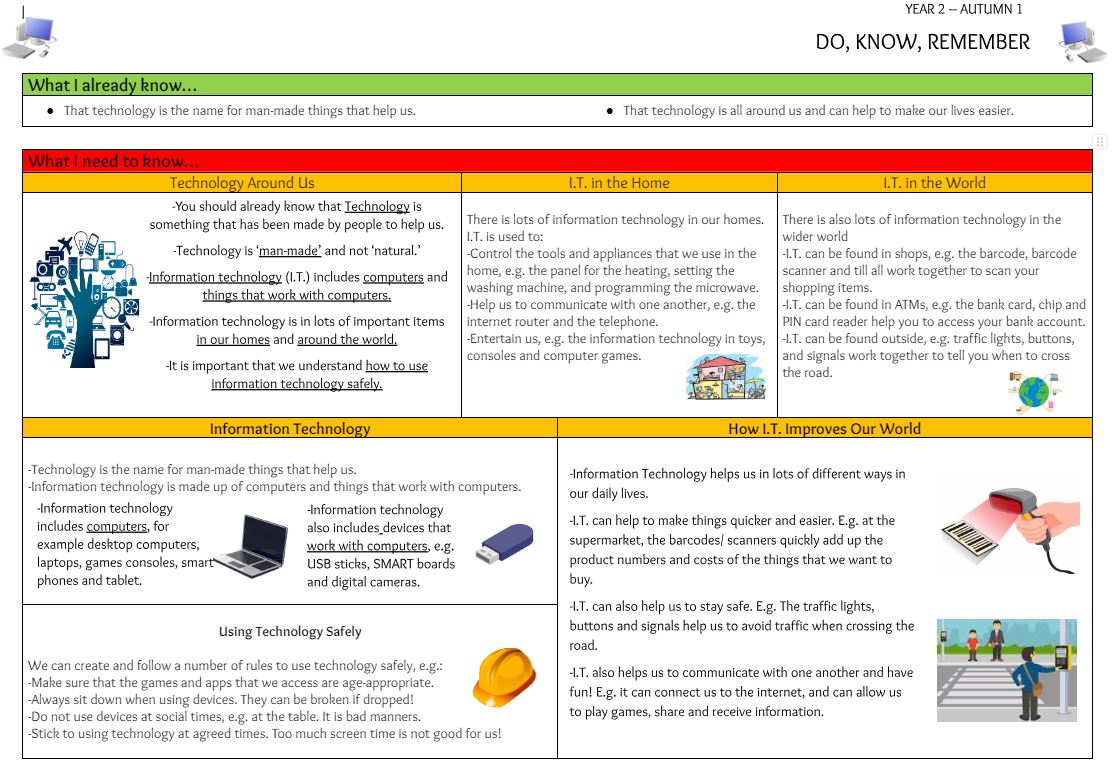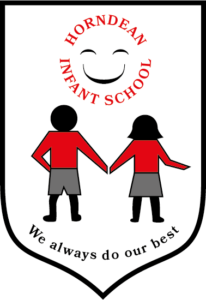Computing
Our Intent, Implementation and Impact statement for Computing
Intent
At Horndean Infant School, we aim to deliver a high quality, engaging and relevant Computing curriculum. Our intent is to equip our pupils with the essential knowledge they need to become digitally literate, active, safe and respectful early participants in our ever-advancing digital and technological world. Across all subjects, we want our pupils to use information technology as a tool to help them enrich their learning and to share and organise their ideas confidently and safely. We also want our pupils to make healthy lifestyle choices in relation to information technology and digital content to ensure that they continue to enjoy the wonder of the wider world around them. We believe that all of this begins in the early years and we aim to instill an essential bedrock of computing knowledge in our youngest pupils to ensure that they make good progress in the next stage of their education in Year One and beyond.
Implementation
Our Computing curriculum ensures that our pupils have a solid foundation of basic computing knowledge by the end of Year F and fulfills the requirements of the National Curriculum in Key Stage One. We have chosen to follow the National Center for Computing Education’s ‘Teach Computing’ Curriculum. This scheme was chosen as it has been created by subject experts and is based on recent pedagogical research. We have adapted some parts of it to make our curriculum more relevant for our pupils. For example,….. . Another part of the ‘Teach Computing’ curriculum that we felt we needed to adapt for our school was the fact that there are no units of work for early years pupils. As we believe children’s early years must provide strong foundations for all future learning, and in the absence of a specific Technology area of learning, we have devised our own linked, cross curricular, units of work and end of year outcomes for Year F to ensure that our youngest pupils are challenged and prepared for the next stage of their education.
Our Computing curriculum is a spiral curriculum and is structured into 6 units per year, starting in Year F. Each of the themes introduced in Year F are revisited in Year One and Year Two through a new unit that consolidates and builds on prior learning within that theme. This style of curriculum design reduces the amount of knowledge lost through forgetting, as topics are revisited yearly. It also ensures that connections are made, even if different teachers are teaching the units within a theme in consecutive years. Computing lessons have dedicated timetable time – four sessions of an hour and a half are taught per halt term and, after new learning has been introduced, children are encouraged to apply their knowledge in different contexts during ‘Growing Learners’. Growing Learners is also used as a time for class teachers to intervene and provide extra support for children who did not achieve the learning objective in individual lessons.
Online safety
The unit overviews for each unit show the links between the content of the lessons and the National Curriculum and Education for a Connected World framework (ncce.io/ efacw). These references have been provided to show where aspects relating to online safety, or digital citizenship, are covered within the Teach Computing Curriculum. Not all of the objectives in the Education for a Connected World framework are covered in the Teach Computing Curriculum, as some are better suited to personal, social, health, and economic (PSHE) education; spiritual, moral, social, and cultural (SMSC) development; and citizenship. However, the coverage required for the computing national curriculum is provided. Schools should decide for themselves how they will ensure that online safety is being managed effectively in their setting, as the scope of this is much wider than just curriculum content. Our school also takes part in ‘Safer Internet Day’.
E-Safety and Digital Citizenship
A key part of implementing our computing curriculum was to ensure that safety of our pupils is paramount. We take online safety very seriously and we aim to give children the necessary skills to keep themselves safe online. Children have a right to enjoy childhood online, to access safe online spaces and to benefit from all the opportunities that a connected world can bring them, appropriate to their age and stage.
Children build online resilience through the use of the ‘Project Evolve – Education for a Connected World’ framework. The framework aims to support and broaden the provision of online safety education, so that it is empowering, builds resilience and effects positive culture change. The objectives promote the development of safe and appropriate long-term behaviours, and support educators in shaping the culture within their setting and beyond.
Within each year group topics include:
- Self Image and Identity – This strand explores the differences between online and offline identity beginning with self-awareness, shaping online identities and media influence in propagating stereotypes. It identifies effective routes for reporting and support and explores the impact of online technologies on self-image and behaviour.
- Online Relationships – This strand explores how technology shapes communication styles and identifies strategies for positive relationships in online communities. It offers opportunities to discuss relationships, respecting, giving and denying consent and behaviours that may lead to harm and how positive online interaction can empower and amplify voice.
- Online Reputation – This strand explores the concept of reputation and how others may use online information to make judgements. It offers opportunities to develop strategies to manage personal digital content effectively and capitalise on technology’s capacity to create effective positive profiles.
- Online Bullying – This strand explores bullying and other online aggression and how technology impacts those issues. It offers strategies for effective reporting and intervention and considers how bullying and other aggressive behaviour relates to legislation.
- Managing Online information – This strand explores how online information is found, viewed and interpreted. It offers strategies for effective searching, critical evaluation of data, the recognition of risks and the management of online threats and challenges. It explores how online threats can pose risks to our physical safety as well as online safety. It also covers learning relevant to ethical publishing.
- Health Well-being and Lifestyle – This strand explores the impact that technology has on health, well-being and lifestyle e.g. mood, sleep, body health and relationships. It also includes understanding negative behaviours and issues amplified and sustained by online technologies and the strategies for dealing with them.
- Privacy and Security – This strand explores how personal online information can be used, stored, processed and shared. It offers both behavioural and technical strategies to limit impact on privacy and protect data and systems against compromise.
- Copyright and Ownership – This strand explores the concept of ownership of online content. It explores strategies for protecting personal content and crediting the rights of others as well as addressing potential consequences of illegal access, download and distribution.
This Framework is supplemented by the use of the Common Sense Education Scheme, providing further resources and links to digital literacy. The activities empower learners to think critically, behave safely, and participate responsibly in our digital world – 21st-century skills which are essential for children and young people to harness the full potential of technology for learning.
These schemes of learning:
- Offer a comprehensive yet balanced approach in addressing safety and security concerns, including ethics and behaviour issues, as well as digital literacy skills.
- Provide child-centred, media-rich lesson materials that emphasize skill building, critical thinking, ethical discussion, media creation, and decision making
- Address the whole community by providing materials to educate parents and families about digital citizenship
- Provide additional resources and links and suggestions for curriculum opportunities
To help with our implementation of the computing curriculum we have a variety of hardware available to pupils and teachers, including:
- laptops
- ipads
- Beebots with accessories (e.g. pen holders)
- An interactive white board connected to a desktop computer in each class
- Sound buttons and pegs
- Remote controlled cars
- CD players and Story Phones
We use the following software to implement our Computing Curriculum:
- ScratchJr
- Microsoft Word
- Microsoft Paint
- Microsoft PowerPoint
- BusyThings
Technical support is provided by our education IT support specialist, Drift IT Services.
Impact
Progress of our computing curriculum is demonstrated through outcomes and the record of coverage in the process of achieving these outcomes.

